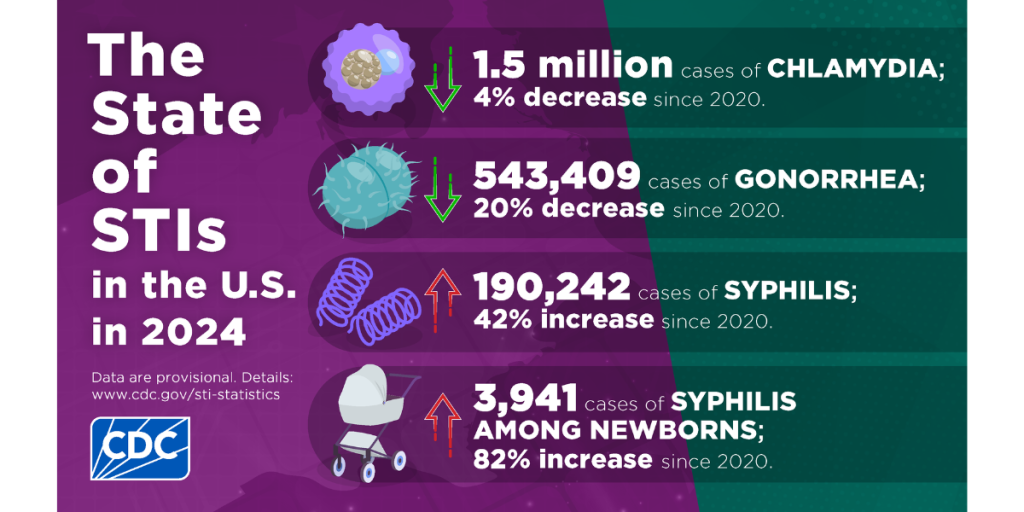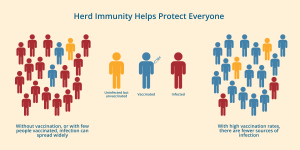
There Are Two New Drugs to Treat Gonorrhea
The FDA approved two new drugs to treat gonorrhea The new drugs—gepotidacin and zoliflodacin—are both new kinds of antibiotics and represent the first completely new treatment options in over thirty years.

The CDC just released STI Surveillance Data for 2024 that show cases of chlamydia, gonorrhea, and syphilis are slowly declining. Some highlights from the report include:
These numbers suggest the United States is making progress in stemming the surging STI epidemic by promoting widespread screening and new prevention methods such as doxy PEP. While this progress is great, there were still 2.2 million cases reported to the CDC in 2024 which represents a 13% increase from a decade ago.
The data also show that congenital syphilis remains one of the biggest public health concerns. Congenital syphilis occurs when syphilis infection is passed from mother to child during pregnancy or birth. This can cause miscarriage, stillbirth, and even infant death. Babies born with syphilis can face lifelong medical issues. Congenital syphilis can be prevented by testing all women during pregnancy and providing treatment if needed. The alarming rise in congenital syphilis in recent years shows big gaps in prenatal care across the country.
In 2024 there were 4,000 cases of congenital syphilis reported which represents a 1.6% increase from 2023. This was much less of an increase than we’ve seen in recent years, but it was still the 12th year in a row that cases of congenital syphilis increased. Moreover, the number of cases is up 700% from a decade ago.
The CDC only released national data from 2024 and considers these numbers provisional. The agency has been working internally and with health departments across the country to update the surveillance system. This has meant delays in collecting and analyzing data. We don’t yet have state data or breakdowns based on demographics like race and ethnicity.
Still, the CDC believes the national data it has released can help inform ongoing STI prevention efforts on the national, state, and local. Full results won’t be available until 2026, and the CDC notes that these provisional data might change slightly at that time.

The FDA approved two new drugs to treat gonorrhea The new drugs—gepotidacin and zoliflodacin—are both new kinds of antibiotics and represent the first completely new treatment options in over thirty years.

The American Cancer Society (ACS) released new recommendations for cervical cancer screening that focus on HPV testing and approve the use of self-collected samples. The recommendations also clarify the age at which screening should start and stop.

A committee that advises the Centers for Disease Control and Prevention (CDC) made an alarming change to the recommendations for the hepatitis B vaccine that will leave some infants unprotected.

A new report from the World Health Organization (WHO) warns of rising levels of drug-resistant gonorrhea. The data comes from reported cases of gonorrhea in 12 countries across five WHO regions.

We’ve known for years that the HPV vaccine works. Now new research shows that widespread vaccination even protects those who haven’t gotten the shot. This study proves that it is possible to reach herd immunity for HPV.

HPV is one of the most common sexually transmitted infections. Still, finding out that you or your partner has it can feel stressful and confusing. It’s normal to have a lot of questions: What does this mean for our health? Did someone cheat? Should we

Experts say that vaccinating newborns against hepatitis B is one of the most important things we do to protect infants.

Hepatitis is an inflammation of the liver that can be caused by a group of viruses—hepatitis A, B, C, D and E. When hepatitis viruses damage liver cells, scar tissue is formed and those cells can no longer function.
ASHA believes that all people have the right to the information and services that will help them to have optimum sexual health. We envision a time when stigma is no longer associated with sexual health and our nation is united in its belief that sexuality is a normal, healthy, and positive aspect of human life.
ABOUT
GET INVOLVED
ASHA WEBSITES
GET HELP
© 2025 American Sexual Health Association